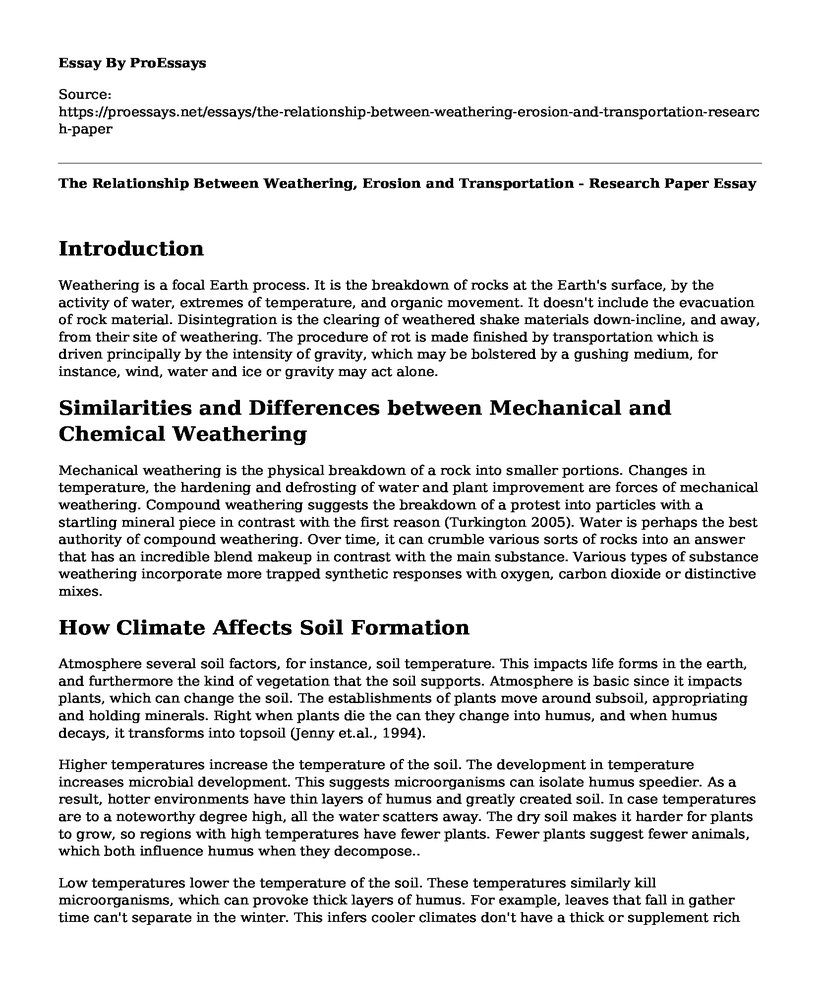Introduction
Weathering is a focal Earth process. It is the breakdown of rocks at the Earth's surface, by the activity of water, extremes of temperature, and organic movement. It doesn't include the evacuation of rock material. Disintegration is the clearing of weathered shake materials down-incline, and away, from their site of weathering. The procedure of rot is made finished by transportation which is driven principally by the intensity of gravity, which may be bolstered by a gushing medium, for instance, wind, water and ice or gravity may act alone.
Similarities and Differences between Mechanical and Chemical Weathering
Mechanical weathering is the physical breakdown of a rock into smaller portions. Changes in temperature, the hardening and defrosting of water and plant improvement are forces of mechanical weathering. Compound weathering suggests the breakdown of a protest into particles with a startling mineral piece in contrast with the first reason (Turkington 2005). Water is perhaps the best authority of compound weathering. Over time, it can crumble various sorts of rocks into an answer that has an incredible blend makeup in contrast with the main substance. Various types of substance weathering incorporate more trapped synthetic responses with oxygen, carbon dioxide or distinctive mixes.
How Climate Affects Soil Formation
Atmosphere several soil factors, for instance, soil temperature. This impacts life forms in the earth, and furthermore the kind of vegetation that the soil supports. Atmosphere is basic since it impacts plants, which can change the soil. The establishments of plants move around subsoil, appropriating and holding minerals. Right when plants die the can they change into humus, and when humus decays, it transforms into topsoil (Jenny et.al., 1994).
Higher temperatures increase the temperature of the soil. The development in temperature increases microbial development. This suggests microorganisms can isolate humus speedier. As a result, hotter environments have thin layers of humus and greatly created soil. In case temperatures are to a noteworthy degree high, all the water scatters away. The dry soil makes it harder for plants to grow, so regions with high temperatures have fewer plants. Fewer plants suggest fewer animals, which both influence humus when they decompose..
Low temperatures lower the temperature of the soil. These temperatures similarly kill microorganisms, which can provoke thick layers of humus. For example, leaves that fall in gather time can't separate in the winter. This infers cooler climates don't have a thick or supplement rich layer of topsoil. In impressively colder territories, plants can't create using any and all means. Along these lines, spots to a high degree cool airs consistently have less made soil layers. Crisp airs have soil layers that look like deserts. This is on account of the two territories don't have plants to change subsoil into made topsoil.
References
Jenny, H., & Amundson, R. (1994). Factors of soil formation: A system of quantitative pedology. New York: Dover.
Turkington, A. (2005). Weathering and landscape evolution. Amsterdam: Elsevier.
Cite this page
The Relationship Between Weathering, Erosion and Transportation - Research Paper. (2022, Jul 25). Retrieved from https://proessays.net/essays/the-relationship-between-weathering-erosion-and-transportation-research-paper
If you are the original author of this essay and no longer wish to have it published on the ProEssays website, please click below to request its removal:
- Renewable and Nonrenewable Sources Essay
- Essay Sample on Deforestation as a Global Concern
- Essay Sample on Oil Dispersants: Evaluating Risks of Exposure to Marine Species
- Essay Example on Winter Survival: Nature's Mysteries, Animal Adaptations
- Essay Sample on IPCC AR5: Climate Change and Its Impact on Oceans
- Essay Example on Los Angeles' Sustainable City Plan: Connecting the Dots for Lasting Change
- Report Example on Management of Stormwater







